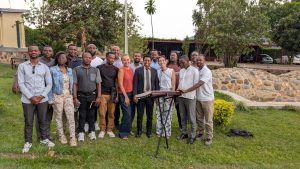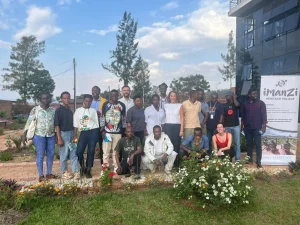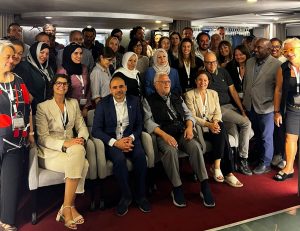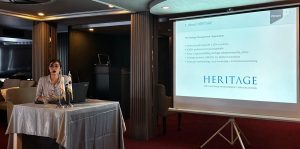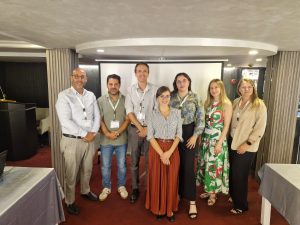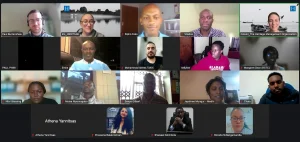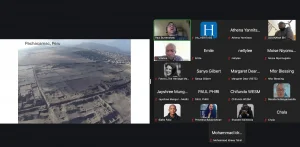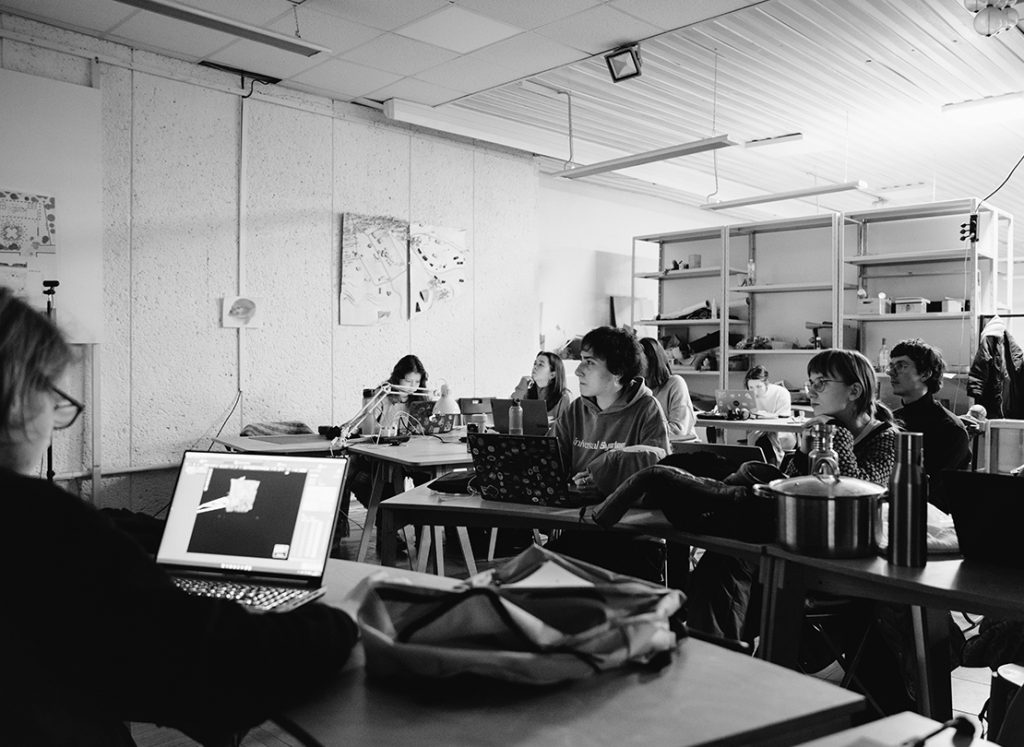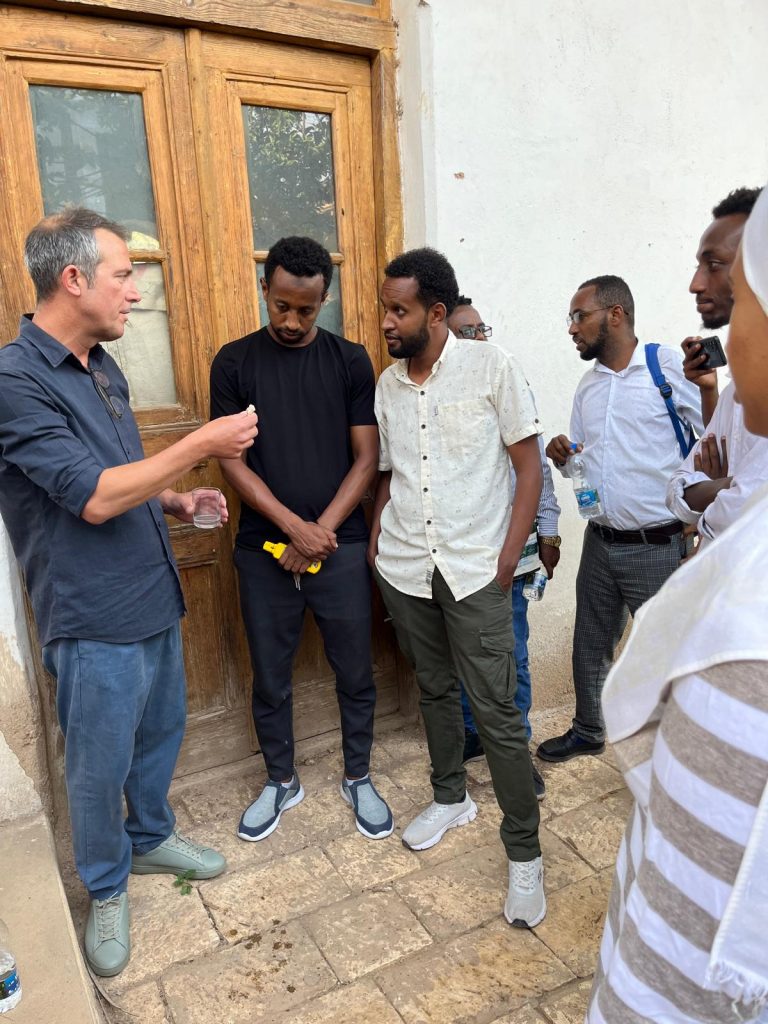: Uncategorized
From Nyamasheke to Kigali: Empowering Communities Through Cultural Heritage in Rwanda
By Eirini Oikonomidi, Rwanda Projects Manager
During the recent, nearly month-long visit to Rwanda, two successful and highly engaged workshops were conducted under the theme: “Engaging Communities in Cultural Heritage.” The training gathered 37 heritage practitioners who offered valuable insights, exchanged knowledge, and shared on-the-ground experience.
The workshops were led by Lena Stefanou and Aris Anagnostopoulos, whose expertise guided participants through practical strategies for community involvement.
The first workshop took place in the southwestern region of Rwanda, in Nyamasheke. This location was strategically chosen because the area is considerably more remote from Kigali, marking a significant step in expanding our programme’s on-site presence. Partnering with IVOMO, who provided crucial organisation and coordination support, the workshop focused intensely on local needs and specific challenges faced by communities in the Great Lakes region. The week spent in this tropical landscape underscored the importance of reaching remote areas to ensure a broad national impact.
Following the Nyamasheke session, the second workshop was hosted in Kigali, the capital of the country. This session broadened the discussion to encompass a wider range of stakeholders, organisations, and dynamic national applications. Our essential partner, the Rwanda Cultural Heritage Academy (RCHA), as always, provided excellent logistical support, including the necessary room and materials at the Kandt House Museum.
Ultimately, both intensive workshops provided fertile ground for the exchange of knowledge, the development of strategies, and the reinforcement of the role of local communities in the protection, preservation, and utilisation of cultural heritage as a driver for sustainable development.
Field Visits and Strategic Engagement
Following the successful completion of the workshops, the remaining weeks of the mission were dedicated to crucial field visits and high-level stakeholder meetings across Rwanda. As the Country Manager, I embarked on an extensive schedule to personally visit projects on the ground, covering a significant geographical expanse—from the tranquil shores of Lake Kivu in the west, across to the Ngoma District in the east, and down into the Southern Province.
This commitment to comprehensive on-the-ground presence yielded two vital outcomes for both our organisation and our local partners.
First, for me, the visits provided a vastly improved and granular understanding of the actual situation. Observing the projects firsthand allowed me to gain immediate clarity on their evolution, their current state, the specific difficulties local teams face, and their overall trajectory. This practical insight is indispensable for effective strategic planning.
Second, the impact on our local partners and the communities themselves was equally profound. By prioritising this on-site presence, we achieved a deeper connection that served to empower the local teams significantly. Our physical presence demonstrated a genuine interest and commitment, signaling the high value we place on their efforts and achievements. We had the opportunity to meet the dedicated individuals face-to-face, fostering stronger personal and professional relationships that reinforce the communities’ sense of ownership and dedication to the long-term sustainability of their cultural heritage work.
In short, these field visits transformed our theoretical understanding into tangible knowledge, strengthening both our project oversight and the foundational local partnerships necessary for lasting impact in Rwanda.
HERITΛGE at the Conference on Sustainable Tourism
From 8 to 11 October 2025, The Heritage Management Organization (HERITΛGE) participated in the 7th Cultural Sustainable Tourism (CST) Conference, hosted in the historic cities of Aswan and Luxor, Egypt. The event brought together experts from across the globe to explore how cultural tourism can foster authentic exchanges, strengthen communities, and advance sustainable development through heritage.
Representing HERITΛGE, Denise Navarro Becerra, Program Manager for M Gambia, presented the paper:“Strengthening Local Capacities for Cultural Tourism Development: The HerMaP Gambia Initiative (2020–2025)”.
The presentation highlighted how the EU-funded initiative supported peer-led capacity building, institutional partnerships, and community-based tourism development in The Gambia demonstrating HERITΛGE’s methodology for building locally rooted, sustainable heritage systems.
The CST 2025 program addressed some of the most pressing challenges in heritage and tourism today. Sessions were organized under themes such as:
- Bridging Past and Present: Valuation and Interpretation of Tangible and Intangible Heritage
- Community, Culture, and Local Engagement in Tourism
- From Stones to Stories: Negotiating Tangible and Intangible Heritage Across Continents
- Cultural Heritage, Identity & Interpretation
Presenters included researchers and practitioners from Italy, Portugal, Spain, Morocco, Egypt, Lebanon, Taiwan, the Philippines, Mexico, Georgia, and beyond, reflecting the global scope of the dialogue and the relevance of cultural tourism across diverse contexts.
While in Egypt, the HERITΛGE team also had the pleasure of reconnecting with Dr. Hassan Refaat, HERITΛGE fellow and grant awardee, whose ongoing work continues to contribute meaningfully to sustainable heritage development in the region.
HERITΛGE received strong interest from institutions and professionals seeking future collaboration, particularly on integrating heritage training, community engagement, and tourism development. The conference provided a valuable opportunity to share lessons from the HerMaP Gambia initiative and reaffirm HERITΛGE’s commitment to co-creating sustainable, community-led heritage programs in Africa and globally.
HERITΛGE Workshop on Community and Economic Development
HERITΛGE recently hosted an online workshop on Community and Economic Development, bringing together 20 heritage managers from 16 countries across Africa and Asia. The three-day intensive training aimed to strengthen participants’ understanding of how cultural heritage can be mobilised for sustainable economic benefit while supporting community development.
The programme was designed to provide heritage managers worldwide with a firm understanding of the motivations for mobilising cultural resources for economic benefit, the limits of that mobilisation, different strategies for creating economic benefits, and how economic impacts are measured and communicated. Participants were guided through the process of developing plans for their own case studies, including goal setting, strategy selection, assessing economic feasibility, and establishing monitoring and evaluation procedures.
The workshop was led by Dr Paul Burtenshaw and Athena Yannitsas. Dr Burtenshaw is a specialist in heritage economics, heritage tourism, and the relationship between cultural heritage and sustainable community development. He has worked on heritage and tourism projects in a range of countries, focusing on how economic approaches can support long-term preservation and local benefit. Athena Yannitsas, Intercultural Initiatives Manager at HERITΛGE, works on programme development, training facilitation, and cross-cultural collaboration. Her work helps align HERITΛGE’s activities with the cultural contexts of diverse communities. Together, they guided participants through a structured and practical learning process linking economic concepts with real-world application.
The Tutor’s approach to stimulate “Thinking outside the box” ideas among participants to brainstorm, identify, develop, scale-up and enhance economic resilience and profitability of the Cultural Heritage.
Paul Phiri / Executive Director at PAZESA Horticultural Community
In total, the course involved 18 capacity-building cases and 19 case studies across two continents, with participants representing a wide range of organisations from Afghanistan, Cameroon, Egypt, Ethiopia, Eswatini, Kenya, Lesotho, Malawi, Malaysia, Mauritius, Niger, Nigeria, Rwanda, South Africa, Uganda, and Zambia.
Throughout the workshop, participants examined how cultural heritage can serve as an economic asset while ensuring that local communities benefit directly. Sessions covered the main sources of income in heritage, such as public funding, donations, and commercialisation, and discussed approaches to integrating sustainability within these models. A particular focus was placed on addressing local needs and priorities, including job creation, cultural preservation, and youth engagement.
Participants also explored ways to generate economic impact through cultural tourism and artisan production, analysing both the opportunities and challenges of these approaches. Further sessions addressed business viability and sustainability, including market-driven product development, audience segmentation, and the five Ps of marketing. Practical exercises on costing and financial planning helped participants assess the feasibility of their proposed initiatives.
Paul was such a great instructor, got me thinking about many things, especially in skills development, capacity building and governance. Hearing his experiences enriched the course. The session on M&E is particularly something that I have struggled with and I have learnt to keep the tools simple and to invent my own to suit my projects.
Margaret Dear Kasande-Köbel / Crafts Manager at Rwenzori Sustainable Trade Centre Limited
The final part of the training focused on capacity building and long-term sustainability, highlighting the importance of developing skills and confidence within communities to manage heritage enterprises independently. The course concluded with a session on monitoring and evaluation, which covered how to design measurable indicators, track progress, and use data to improve project outcomes.
By the end of the workshop, participants had developed frameworks outlining their project goals, strategies, and measures of success, supporting the implementation of sustainable economic development initiatives in their respective contexts.
For more information about HERITΛGE’s workshops, go to our open courses page, or follow us on Facebook, Twitter / X, LinkedIn or Instagram.
Reflections on a year of Architectural Heritage Preservation in Times of War: The Ukrainian Model
In times of war, when destruction seems to rewrite the physical and cultural landscape of a nation, a different kind of architecture emerges – one built from knowledge, skill, and an unyielding commitment to protect memory. The project “Architectural Heritage Preservation in Times of War: The Ukrainian Model” stands as a powerful example of what can be accomplished when education, resilience, and international collaboration converge with urgency.
Launched in September 2024 by HERITΛGE in collaboration with the Kharkiv School of Architecture (operating from Lviv) and 3D documentation experts of Skeiron, this project set out to train a new generation of heritage architects and educators equipped with the technical and ethical tools needed to preserve Ukraine’s imperiled architectural heritage.
Building knowledge amid collapse
As buildings fall and monuments come under attack, the project focused on something less visible but deeply enduring: education. Over the course of the academic year, it reached 30 students and 10 educators from across Ukraine – Chernivtsi, Dnipro, Kharkiv, Kherson, Poltava, Zaporizhzhia, Kyiv, Odesa, Lviv and Vinnytsia regions – through an intensive curriculum that merged theory with fieldwork. Topics ranged from cutting-edge techniques like photogrammetry and 3D laser scanning to international conservation standards and legal frameworks.
Field internships in Western Ukraine led by Skeiron gave students hands-on experience in documenting heritage sites. They produced high-resolution digital scans and architectural records that now serve both as tools for future conservation efforts and as acts of cultural preservation in their own right.
In parallel, the programme’s educator training combined online learning with in-person workshops coordinated and hosted by the Kharkiv School of Architecture and practical exercises. This dual approach enabled participating teachers to develop their own heritage-focused curricula – tailored to their institutions – and expand the reach of conservation education across the country.
The urgency of this work is echoed in the April 2025 report “The Ukrainian Cultural Sector in Wartimes: Emergencies – Needs – Measures”, which highlights a critical shortage of qualified professionals in conservation, restoration, and heritage protection. The report calls for systemic investment in education, especially in frontline regions where remote-only instruction has left gaps in competencies. Against this backdrop, the project addressed not just a wartime emergency, but a long-standing structural need for enhanced education in architectural heritage conservation.
The project’s broader legacy
Though limited to one academic year, the project’s impact far outstrips its timeline. It catalysed the development of a reproducible curriculum, created a set of digital documentation of 15 heritage sites, and introduced conservation methodologies to institutions that previously had limited access to such tools. Perhaps most importantly, it demonstrated how cultural preservation can be reframed as a form of resistance and recovery.
A series of public webinars and lectures – featuring experts from Ukraine and abroad – helped bridge gaps in knowledge and connect students and instructors with global heritage preservation communities. The programme didn’t just train students; it helped cultivate a network of professionals who carry forward the mission of architectural conservation with firsthand experience and shared purpose.
A call to sustain what was started
Despite its success, the project ended in 2025 due to funding limitations. Its early closure is a sobering reminder of the fragility of cultural preservation efforts in conflict zones. Yet it also underscores a core truth: the preservation of architectural heritage is not a one-off intervention. It is a long-term commitment that demands sustained investment, institutional backing, and policy support.
The tools have been built. The knowledge has been shared. What remains is the will to continue – through new programs, policy reform, and the support of international allies.
Final thoughts
In Ukraine today, every carved facade, every war-scarred cornice tells a story – not only of destruction but of survival. The “Architectural Heritage Preservation in Times of War” project ensured that these stories are not lost. As Ukraine continues its path through war toward recovery, the architects trained through this programme will stand among its quiet heroes – those who understand that rebuilding is not just about walls, but about the memory those walls hold.
Now, more than ever, we must ask: what kind of future do we build if we let the past be erased?
Find out more about our projects here.
You’re Invited: Join Us for the Presentation of Our Summer School on Engaging Communities in Cultural Heritage
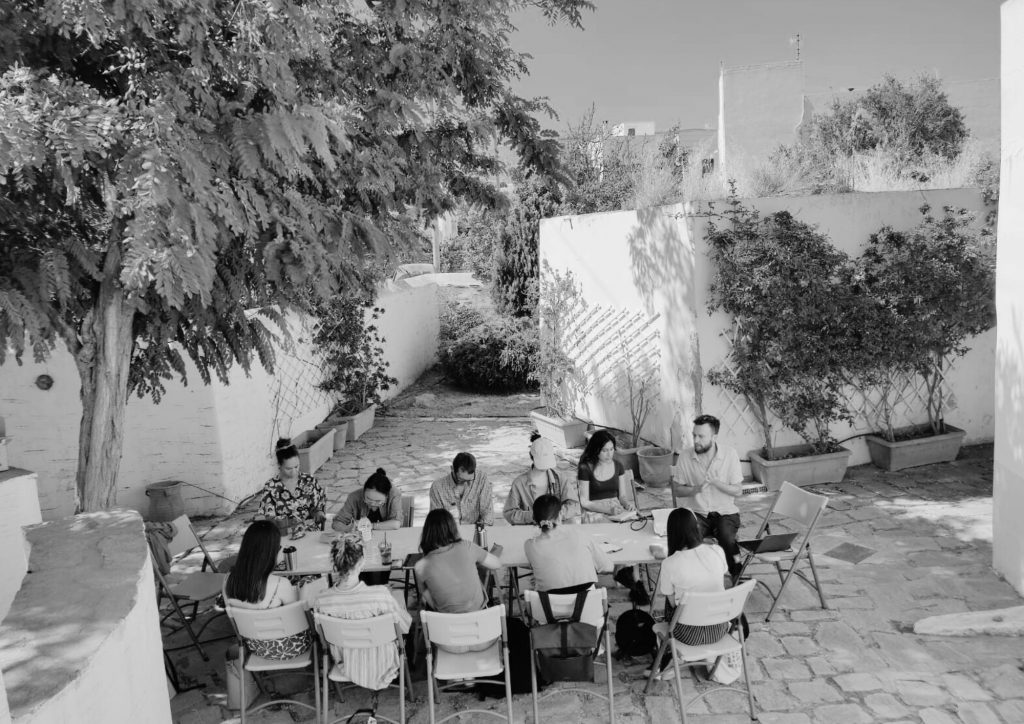 We are delighted to invite you to the closing presentation of the International Summer School on Engaging Communities in Cultural Heritage, taking place on Sunday, July 6, 2025, at 20:00, at the Dimitrakopoulos Building in Paroikia, Paros.
We are delighted to invite you to the closing presentation of the International Summer School on Engaging Communities in Cultural Heritage, taking place on Sunday, July 6, 2025, at 20:00, at the Dimitrakopoulos Building in Paroikia, Paros.
Over the past two weeks, a dynamic group of heritage professionals and students from around the world has been working closely with the island’s local communities. Through hands-on fieldwork and ethnographic research, they’ve explored how communities engage with their cultural heritage and how local initiatives contribute to its preservation and promotion.
This special event will showcase the results of their field research, offering insights into the role that local voices play in shaping the narratives and practices of heritage management. It is an opportunity to hear directly from participants about their experiences, findings, and reflections—and to learn how community engagement can enrich the global conversation around cultural heritage.
Now in its second year of in-person implementation on the island, the program places special emphasis on interaction with local cultural organizations. A central aim of the Summer School is to highlight, through the educational process, the work of local cultural institutions as case studies that can enrich the international dialogue on the protection and promotion of cultural heritage.
The Summer School is made possible thanks to the generous support of the Municipality of Paros, which has provided access to local venues, including the Dimitrakopoulos Building and the Municipal Library.
We warmly invite local residents, cultural professionals, and visitors to join us for this celebratory and insightful evening. Come meet the next generation of heritage managers, discover the rich cultural fabric of Paros through fresh perspectives, and take part in a growing dialogue on how communities shape their heritage futures.
Date: Sunday, July 6, 2025
Time: 20:00
Location: Dimitrakopoulos Building, Paroikia, Paros
We look forward to seeing you there!
Building Local Capacity for Heritage Conservation in Harar Jugal, Ethiopia
by Xanthippi Kontogianni, Ethiopian Program Manager, HERITΛGE
Harar Jugal, the fortified historic town recognized as a UNESCO World Heritage Site, stands as a living testament to Ethiopia’s rich cultural and architectural heritage. With its intricate alleyways, traditional Harari houses, centuries-old mosques, and lively open markets, Harar has long served as a cultural and commercial melting pot. The town holds immense historical value while simultaneously serving as a vibrant home for its local community. However, the preservation of this unique urban landscape is increasingly threatened by urbanization, inadequate maintenance, and the impacts of climate change.
To both leverage Harar Jugal’s potential for the benefit of its contemporary inhabitants and safeguard the historic center for future generations, there is a pressing need to develop specialized skills in heritage conservation, traditional building techniques, and sustainable urban management. Strengthening local capacity in these areas is essential to ensure that the cultural and historical integrity of Harar remains intact while responding to the evolving needs of its residents.
Walls of Harar Jugal.
In December 2024, the Culture and Tourism Bureau of Harar, one of the key institutions responsible for managing the Harar Jugal historic town, invited HERITΛGE to a virtual meeting. During the meeting, Mohammed Rabi, a representative of the Bureau, proposed organizing a heritage conservation workshop for Bureau staff and close collaborators. In alignment with its mission to train and empower heritage professionals to engage communities in stewarding their cultural assets for greater understanding, sustainability, and economic development, HERITΛGE welcomed the initiative and agreed to deliver the proposed training in Harar.
The workshop on Heritage Conservation was conducted in a blended format, combining online and in-person sessions held on 7-9 and 21-23 May 2025, respectively. This flexible format ensured accessibility while supporting dynamic, participatory learning. The training was led by Alexis Stefanis, Assistant Professor of Architectural Conservation at the Department of Conservation of Antiquities and Works of Art, University of West Attica. The curriculum was structured around three core content areas: General Principles of Cultural Heritage Conservation, First Aid for Finds, and Preventive Conservation. The online component delivered core theoretical content through lectures, readings, and discussions, while the in-person sessions emphasized hands-on exercises, group work, and live demonstrations. The workshop attracted 13 participants (8 men and 5 women) and was delivered under HERITΛGE’s HerMaP Ethiopia training program, which is funded by the Humanities in Place initiative of the Mellon Foundation.
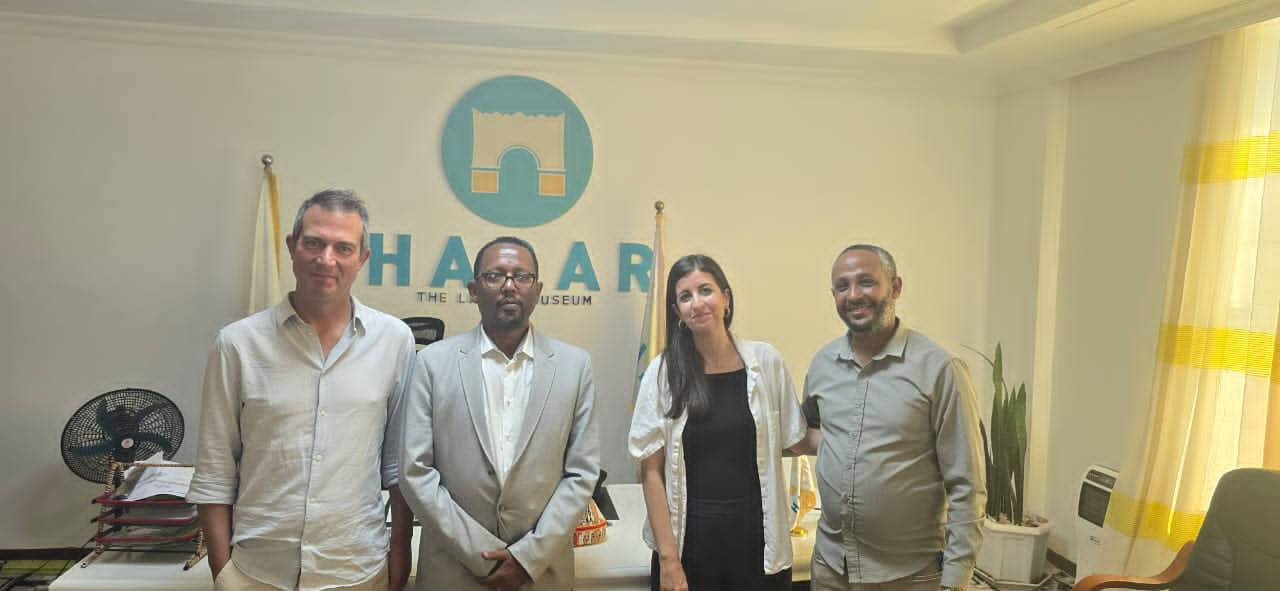 Networking meeting with Mr Teweleda Abdosh Ahmed – Head of Culture, Heritage & Tourism Bureau, Harari People Regional State.
Networking meeting with Mr Teweleda Abdosh Ahmed – Head of Culture, Heritage & Tourism Bureau, Harari People Regional State.
Participant engagement was enthusiastic and highly interactive. The hybrid structure facilitated broad participation, and both components were well-attended. One of the most impactful moments occurred during Dr. Stefanis’s live tool demonstration. After observing how the tools worked and understanding their applications, participants expressed a strong desire to use them directly. Encouraged by the facilitator, they took the tools outside and began applying them at actual heritage sites, collecting data and interpreting results on-site. Many cited this hands-on activity as the most transformative part of the training. Recognizing the value of practical learning, participants formally requested that the tools be made available for their ongoing conservation work.
Dr. Stefanis’s mission to Harar was supported by Natassa Nika, Africa Programs Coordinator at HERITΛGE, and Habtamu Gizawu Tola, HERITΛGE’s local representative in Ethiopia. Together, they met with key stakeholders, including the Culture and Tourism Bureau of the Harari People Regional State, the Construction Permit and Inspection Authority, and the Heritage Department of Haramaya University. These discussions highlighted the urgent need to preserve Harar’s distinctive heritage amid complex challenges. Participants identified priority areas such as capacity building in conservation and digital preservation, community engagement, and institutional strengthening.
These insights aligned with HERITΛGE’s ongoing mapping efforts in Ethiopia. Since launching its intervention program, HERITΛGE has conducted online surveys across the country to assess training needs and identify gaps in heritage management. Findings indicate that many professionals involved in conservation projects lack formal training, especially in areas such as architectural and artifact conservation.
Demonstration of tools.
The workshop and stakeholder meetings in Harar revealed not only the need for training and technical skills but also broader systemic challenges, particularly the lack of funding for project implementation and capacity development. Stakeholders emphasized the importance of collaboration, resource sharing, and establishing equitable partnerships. As a result, HERITΛGE and the Harar Culture and Tourism Bureau committed to ongoing collaboration and began developing a joint action plan.
Brainstorming sessions generated several promising ideas for future collaboration, including co-developing project proposals for funding calls, launching targeted capacity-building programs, and even establishing a university for conservation studies in Harar. As a first step, the partners agreed to draft a series of concept notes collaboratively, with the goal of developing a shared vision that would eventually lead to the signing of a Memorandum of Understanding (MoU) between HERITΛGE and the Bureau—formalizing the new partnership.
Overall, the experience in Harar marked a significant step forward in conservation capacity building and demonstrated the value of inclusive, hands-on training combined with strategic stakeholder engagement. It stands as a strong success story and a foundation for deeper collaboration in the preservation of Ethiopia’s unique cultural heritage.

